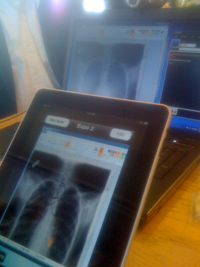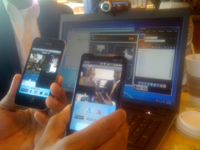
 Earlier this month I had a briefing with the CEO (Siva Chaturvedi) and CTO (Satish Gundabathula) of the Dallas and India-based mobile UC developer, Damaka. The management team was passing through central Massachusetts as part of an analyst roadshow highlighting their latest capabilities for mobile collaboration and I was asked to participate. I spent an hour with the team at a local StarBucks. The demos presented were very impressive.
Earlier this month I had a briefing with the CEO (Siva Chaturvedi) and CTO (Satish Gundabathula) of the Dallas and India-based mobile UC developer, Damaka. The management team was passing through central Massachusetts as part of an analyst roadshow highlighting their latest capabilities for mobile collaboration and I was asked to participate. I spent an hour with the team at a local StarBucks. The demos presented were very impressive.
Sita showed off (at right) an example of a collaboration program running in one instance on the PC (background) and in another on the iPad (foreground). Here markings made by the touch screen user (in this demo he was a  radiologist looking for questionable issues in the chest xray) showed instantly on the PC user’s screen.
radiologist looking for questionable issues in the chest xray) showed instantly on the PC user’s screen.
And, in another scenario (at left), he showed a three-way video conferencing service connecting an iPhone 4 user (left hand), Google Android user (right hand) and a PC user (background). I asked about the networking infrastructure and use of standards, but was told that their patent portfolio (5 issued, 16 pending) describes their ‘self-discovery’ methods used.
Except, it’s not self-discovery. I was thinking that the claim of self-discovery would point to some kind of broadcast method or maybe even some kind of SMS-based ping to get IP addresses of devices. Not true. The patents describe a method where a central host knows something about each of the participants (IP address for example) and shares it as appropriate. This is how every SIP, H.323, Instant Messaging, VoIP and even Skype (proprietary) service works – because it’s efficient. Every device can learn where the host is. The host can keep track of who’s available and who is not.
The challenges for the company are not technical. The products work and the demos prove they can be quite impressive – especially over a coffee shop WiFi – since getting an Android to communicate with an iPhone (other than making a call or sending an SMS) is currently unusual. The challenges are centered around distribution (sales) and targeted selling. Who is the market they hope to serve and how will they compete against the myriad other solutions, many of which are reviewed on this site, is the central question?
In my initial review of the company and solution, I learned that the company was focusing on tier 2 mobile operators in Asia (because that’s where their Israeli systems integrator, Starhome is focused) and are more recently collaborating with Alcatel-Lucent to bring the capabilities to the healthcare industry. I will look forward to learning more about the market developments since, from what I can see, this is a real challenge for the company. Bringing great new technologies to the enterprise communications market is usually more about the channels and sales model and less about the technologies.









